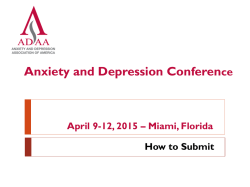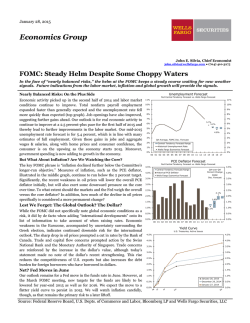
Spanish Version of the Meta-Cognitions Questionnaire 30 (MCQ
Spanish Journal of Psychology (2013), 16, e95, 1–8. © Universidad Complutense de Madrid and Colegio Oficial de Psicólogos de Madrid doi:10.1017/sjp.2013.95 Spanish Version of the Meta-Cognitions Questionnaire 30 (MCQ-30) Juan Ramos-Cejudo1, José M. Salguero2 and Antonio Cano-Vindel1 1 2 Universidad Complutense (Spain) Universidad de Málaga (Spain) Abstract. The Meta-cognitions Questionnaire 30 (MCQ-30; Wells & Cartwright-Hatton, 2004) has been used to assess individual differences in metacognitive beliefs considered to be central in the metacognitive theory of generalized anxiety disorder (Wells, 2005). In the present study, the psychometric properties, reliability, and validity of a Spanish adaptation of the MCQ-30 were tested in a broad sample of participants (N = 768) of Spanish nationality aged 16–81 years (31.1% males, 68.9% females). Confirmatory factor analysis showed the expected five-factor structure, which was found to be invariant across gender. Internal consistency and test-retest reliability of the subscales were adequate, and the expected relationships to theoretically related variables such as pathological worry, meta-worry, thought suppression and trait anxiety were obtained. Convergent validity with other measures of beliefs about worry was also found. Taken together, these findings suggest that the Spanish version of the MCQ-30 is a valid instrument for evaluating metacognitive beliefs in the Spanish-speaking population. Received 11 April 2012; Revised 25 July 2012; Accepted 8 November 2012 Keywords: meta-cognition, meta-cognitions questionnaire, Spanish adaptation, psychometric properties. Worry is a relatively normal cognitive process in the general population (Tallis, Davey, & Capuzzo, 1994), but it becomes problematic in people with generalized anxiety disorder (GAD) because they experience worry with greater frequency, intensity and persistence. In recent years, research on GAD has focused on analysing the factors that explain pathological worry, with cognitive models playing an important role (for a review, see Behar, DiMarco, Hekler, Mohlman, & Staples, 2009). Among these, the metacognitive model of GAD (Wells, 1999; 2000; 2005) has received significant attention. Metacognition refers to stable knowledge or beliefs about one´s own cognitive system, knowledge about factors that affect the functioning of the system, regulation and awareness of the current state of cognition, and appraisal of the significance of thought and memories (Wells, 1995, p. 302). This top-down conceptualisation suggests that metacognitive beliefs guide the selection of worry as a coping strategy and lead to negative appraisals of worry, termed meta-worry (Wells, 2000). The metacognitive model of GAD, which is based on a broader model of emotional disorders called the self-regulatory executive function (S-REF, Wells & Matthews, 1994), proposes that repetitive, Correspondence concerning this article should be addressed to Juan Ramos-Cejudo. Department of Personality. Evaluation and Psychological Treatment II (Differential Psychology). School of Psychology. Universidad Complutense. Campus de Somosaguas. 28223 Madrid (Spain). Email: [email protected] uncontrollable worry in GAD is linked to an individual’s metacognitive beliefs about worrying (Wells, 2005). For example, when faced with an anxiety-provoking stimulus, individuals having positive beliefs about worry (e.g., “Worry will help me cope”) are prone to use worry as a predominant means of coping. If, during the course of worry, negative beliefs about worry are activated (e.g., “Worry is uncontrollable”, “My worrying is dangerous for me”), individuals engage in negative appraisals about worry, or meta-worry, that intensifies anxiety and maintains perseverative thinking (Wells, 2005). These metacognitive beliefs form part of the information-processing system associated with GAD and with other emotional disorders. In fact, metacognitive beliefs and meta-worry are also associated with other processes that contribute to some emotional disorders, such as thought suppression or avoidance behaviours (e.g. avoidance of situations, reassuranceseeking, alcohol use). Thus, engaging in these ineffective strategies may lead people with GAD to see that worry is dangerous or uncontrollable. To analyse individual differences in metacognitive beliefs and to test the hypotheses of the GAD model, Cartwright-Hatton and Wells (1997) developed the Metacognitions Questionnaire (MCQ). This questionnaire consists of 65 items, with responses on a fourpoint Likert scale; higher scores indicate the presence of more dysfunctional metacognitive beliefs. Preliminary results with the MCQ showed a structure of five related factors (Cartwright-Hatton & Wells, 1997): (1) positive beliefs about worry, which measures the extent to 2 J. Ramos-Cejudo et al. which a person believes that worry is useful; (2) negative beliefs about concern, which measures the extent to which a person believes that worry is uncontrollable and dangerous; (3) cognitive confidence, which assesses confidence in one’s own attention and memory processes; (4) beliefs about the need for control, which assesses the need to control and/or delete some thoughts; and (5) cognitive self-awareness, which assesses the tendency to monitor attention to one’s thoughts. The MCQ showed adequate psychometric properties and the questionnaire subscales positively predicted worry proneness, intrusions, obsessional symptoms, and anxiety (Cartwright-Hatton & Wells, 1997). More recently, in an effort to generate a shorter instrument, Wells and Cartwright-Hatton (2004) developed the Meta-cognitions Questionnaire 30 (MCQ-30). Using a combination of criteria, in particular the factor loadings of the items on the original MCQ, six items were selected as representative of each of the five factors, resulting in a 30-item instrument. MCQ-30 showed evidence of a five-factor structure similar to that of the original scale, as well as adequate psychometric properties in different studies using confirmatory factor analyses and larger population samples (e.g., Spada, Mohiyeddini, & Wells, 2008; Wells & CartwrightHatton, 2004). Consistent with the metacognitive model, the MCQ30 subscales have been related to measures of trait anxiety, thought suppression and pathological worry (Wells, 1995; Wells & Cartwright-Hatton, 2004); higher levels of anxiety and depression (Spada et al., 2008); and a greater tendency to engage in meta-worry (Davis & Valentiner, 2000). MCQ-30 has also been shown to be a useful tool to differentiate patients with GAD from patients with other anxiety disorders and from the general population (Barahmand, 2009; Wells & Carter, 2001). Moreover, the questionnaire has been used with non-clinical populations to analyse the implications of metacognitive beliefs for other emotional disorders and psychological disturbances, such as obsessivecompulsive disorder (Fisher & Wells, 2008; Janeck, Calamari, Riemann, & Heffelfinger, 2003), posttraumatic stress disorder (Holeva & Tarrier, 2001), psychosis and hallucinations (Brett, Johns, Peters, & McGuire, 2009), substance abuse (Spada, Moneta, & Wells, 2007), and chronic fatigue syndrome (Maher-Edwards, Fernie, Murphy, Wells, & Spada, 2011). Recent studies have confirmed the internal consistency and structure of the MCQ-30 in different nonEnglish-speaking populations (Tosun & Irak, 2008; Typaldou et al., 2010). However, a Spanish version has not yet been validated or published, which poses an obstacle to advances in research. The present study sought to develop and validate a Spanish version of the MCQ-30 and test it on a non-clinical Spanish sample to confirm whether its factor structure, psychometric properties and relationships to other constructs are similar to those of the original scale. We also examined measurement invariance across gender. Specifically, we hoped to confirm the original intercorrelated five-factor structure (in both male and female), observe that the subscales have adequate internal consistency and temporal stability over 3 months, and probe the associations between the MCQ-30 and theoretically related variables such as pathological worry, meta-worry, thought suppression, trait anxiety, and other measures of beliefs about worry. Method Participants and procedure A total of 768 participants from two nonclinical samples (31.1% males, 68.9% females), ranging in age from 16 to 81 (M = 31.82, SD = 13.03), completed the Spanish version of the MCQ-30. A subset of 518 participants (31.9% males, 68.1% females), selected using a snowball sampling procedure and ranging in age from 16 to 81 (M = 30.39, SD = 12.67), completed additional tests to evaluate pathological worry, meta-worry, thought suppression and trait anxiety. Another sample of 135 undergraduate students (11.1% males, 88.9% females), ranging in age from 19 to 34 (M = 21.62, SD = 2.38), completed the Spanish MCQ-30 and measures to evaluate beliefs about worry. Among these 135 students, a subset of 115 (8.7% males, 91.3% females), ranging in age from 19 to 29 (M = 21.36, SD = 1.97), completed the Spanish version of the MCQ-30 a second time, 3 months after the first administration. Participants were volunteers who received no credit for participation in the study. The questionnaires were administered in paper-and-pencil format and instructions were provided in writing. Instruments Meta-Cognitions Questionnaire-30 (MCQ-30; Wells & Cartwright-Hatton, 2004) This measure assesses individual differences in metacognitive beliefs, judgments and monitoring tendencies. It comprises five subscales involving a total of 30 items. Responses to each item on the MCQ-30 are on a 4-point Likert scale, from 1 = “do not agree” to 4 = “strongly agree”. MCQ-30 scores range from 30 to 120 points, and higher scores indicate greater pathological metacognitive activity. The five subscales measure the following dimensions: (1) positive beliefs about worry (e.g. ‘‘worrying helps me cope”), (2) negative beliefs of uncontrollability and danger (e.g. ‘‘when I start worrying I cannot stop”), (3) cognitive confidence (e.g. ‘‘my memory can mislead me at times”), (4) need to control Spanish Adaptation of the MCQ-30 3 thoughts (e.g. ‘‘not being able to control my thoughts is a sign of weakness”), and (5) cognitive self-consciousness (e.g. ‘‘I pay close attention to the way my mind works”). The Spanish translation of the MCQ-30 was created using a back-translation procedure involving two independent translators, both of whom were psychologists and experts in GAD. Penn State Worry Questionnaire (PSWQ; Meyer, Miller, Metzger, & Borkovec, 1990) This was designed to capture the generality, excessiveness, and uncontrollability that are characteristic of pathological worry. The reliability and validity of the PSWQ have been widely researched, and the instrument appears to have sound psychometric properties (Molina & Borkovec, 1994). It consists of 16 items, and responses are given on a 5-point scale from 1 = “nothing” to 5 = “a lot”. The original English version had five items, the order of which was inverted in the Spanish version (Nuevo, Montorio, & Ruiz, 2002). This version has a unidimensional structure and has shown good reliability, validity, and internal consistency. Cronbach’s alpha in the present study was .93. Meta-Worry Questionnaire (MWQ; Wells, 2005) This questionnaire assesses thoughts and ideas about worrying. The instrument consists of seven items reflecting dangers of worrying. The MWQ has two response subscales, one designed to assess the frequency of meta-worry and the other designed to assess the belief in each meta-worry. In this study we used only the frequency scale. Cronbach’s alpha for the frequency scale was .88 in the original study (Wells, 2005) and slightly lower (.79) in the present work. White Bear Suppression Inventory (WBSI; Wegner & Zanakos, 1994) This inventory has 15 items that measure people’s general tendency to suppress thoughts; responses range from 1 = “totally disagree” to 5 = “completely agree”. It has shown good internal consistency (α = .89) and test-retest reliability (r = .80). The present study used the Spanish version of the WBSI (Fernández, Extremera, & Ramos, 2004), which has also shown adequate psychometric properties. In the present work, Cronbach’s alpha was .92. 80 points, with higher scores indicating greater anxiety. The Spanish version of the STAI has shown good psychometric properties (Spielberger, Gorsuch, & Luschene, 1982), and Cronbach´s alpha in the present study was .91. Why Worry? (WW; Freeston, Rhéaume, Letarte, Dugas, & Ladouceur, 1994) This 20-item questionnaire identifies and assesses reasons why people say they worry about. The questionnaire has two subscales: (1) believe that worrying can prevent negative outcomes, (2) believe that worrying has positive effects, such as finding a better way of doing things, increasing control, and finding solutions. These scales showed good psychometric properties in both the original version (Freeston et al., 1994) and the Spanish adaptation (González, Bethencourt, Fumero, & Fernández, 2006). In the present study, Cronbach´s alpha for the two subscales was .51 and .85, respectively. Data Analyses The SPSS statistical package (version 19.0) was used to compute descriptive statistics, correlation analyses, and internal consistency. Pearson´s correlation was used to investigate the relationships between MCQ-30 and other measures. EQS 6.1 (Bentler, 1995) was used to perform confirmatory factor analysis (CFA) using the maximum likelihood (ML) method. Since departures from multivariate normality can have a significant impact on maximum-likelihood estimation, we calculated descriptive analytical measures prior to conducting CFA analysis. Since univariate and multivariate kurtosis statistics were found to indicate non-normality, the Satorra-Bentler scaled ML correction was used to adjust the model chi-square (Hu, Bentler, & Kano, 1992). Given the sensitivity of the chi-square statistic to sample size (Floyd & Widaman, 1995), the following additional measures of model fit were used (Schweizer, 2010): the root mean square error of approximation (RMSEA), the Bentler comparative fit index (CFI), and the standardized root mean square residual (SRMR). CFI values above .90 indicate good fit. RMSEA values below .08 are considered a reasonable fit, whereas values below .05 indicate good fit. SRMR values are expected to be below .10 (Schweizer, 2010). Results State-Trait Anxiety Inventory (STAI; Spielberger, 1983) Factor structure and reliability The STAI is widely used to assess anxiety. The instrument is divided into two 20-item sections that assess state and trait anxiety; responses are on a 4-point Likert scale. Only the trait anxiety subscale was used in the present study. Scores on this subscale range from 20 to The hypothesized five factor model showed the following fit indices: S-B χ2 = 1005.86, df = 395, p = .001; normed χ2 (χ2/df) = 2.54; RMSEA = 0.04 (90% CI = 0.04– 0.05); CFI = 0.92; SRMR = 0.05. Globally, these indices indicate a good fit to the data, showing that the 4 J. Ramos-Cejudo et al. five-factor model is acceptable. All factor loadings were higher than .35 (Table 1). Cronbach’s alphas and correlations between the five factors and the total MCQ-30 score are shown in Table 2. Cronbach’s alpha coefficients for the subscales ranged from .69 (need to control thoughts) to .89 (positive beliefs about worry). The alpha coefficient for the total score was .89. These alpha coefficients were acceptable compared to the guideline of Cronbach´s alpha ≥ .70 for being acceptable (Nunnally & Bernstein, 1994). As in previous studies (Spada et al., 2008), the lowest correlation was found between cognitive selfconsciousness and cognitive confidence, whereas the highest correlation was found between negative beliefs of uncontrollability and danger and the need to control thoughts. We also assessed reliability using test-retest correlation. Test-retest reliability over 3 months was acceptable for the majority of the subscales, r = .69 for positive beliefs about worry, r = .69 for negative beliefs about uncontrollability and danger, r = .86 for cognitive confidence, r = .66 for cognitive self-consciousness, and r = .72 for the total MCQ-30 score; however, it was quite low for the need to control thoughts subscale, r = .50. Invariance across gender When the five-factor model was explored across gender, the goodness-of-fit indices were adequate in both Table 1. MCQ-30 items and their standardised factor loadings (N = 768) Item/factor Loading Factor 1: Positive Beliefs Estar preocupado me ayuda a organizar mi mente Estar preocupado me ayuda a afrontar las cosas Necesito preocuparme para funcionar bien Estar preocupado me ayuda a solucionar los problemas Necesito preocuparme para seguir organizado Estar preocupado me ayuda a evitar problemas en el futuro .69 .69 .77 .81 .83 .76 Factor 2: Negative beliefs: Uncontrollability/danger Mis pensamientos preocupantes persisten, independientemente de cómo intente detenerlos Cuando empiezo a preocuparme no puedo parar Podría llegar a enfermar de preocupación No puedo ignorar los pensamientos que me preocupan Mi preocupación podría volverme loco Considero que preocuparme es peligroso para mí .40 .58 .73 .65 .56 .74 Factor 3: Cognitive confidence No confío en mi memoria Tengo mala memoria Tengo poca confianza en mi memoria sobre hechos Tengo poca confianza en mi memoria sobre lugares Tengo poca confianza en mi memoria sobre palabras y nombres Mi memoria me puede engañar a veces .74 .56 .81 .76 .86 .69 Factor 4: Need to control thoughts Si no pudiera controlar mis pensamientos, yo no podría funcionar No poder controlar mis pensamientos es una señal de debilidad Debería controlar mis pensamientos todo el tiempo Es malo tener ciertos pensamientos Si yo no controlara un pensamiento preocupante y luego ocurriese, sería por mi culpa Recibiré un castigo por no controlar ciertos pensamientos Factor 5: Cognitive self-consciousness Soy consciente constantemente de lo que pienso Presto mucha atención a la manera en que mi mente funciona Pienso mucho acerca de mis pensamientos Examino constantemente mis pensamientos Monitorizo mis pensamientos Me doy cuenta de cómo funciona mi mente mientras pienso en cómo solucionar un problema Note: All factor loadings were significant at p < .05. .59 .64 .44 .39 .54 .69 .49 .81 .36 .72 .83 Spanish Adaptation of the MCQ-30 5 Table 2. Means, standard deviations, alpha reliabilities and correlations of the MCQ-30 subscales and total score (N = 768) 1 1. Positive Beliefs 2. Uncontrollability/danger 3. Cognitive confidence 4. Need to control thoughts 5. Cognitive selfconsciousness 6. Total MCQ-30 score M SD α 2 3 4 5 6 – .28 .14 .45 .40 .66 10.14 4.09 .89 – .26 .56 .41 .73 11.54 3.82 .78 – .25 .11 .55 11.42 4.61 .88 – .50 .78 10.11 3.31 .69 – .72 13.93 4.23 .81 – 57.15 13.65 .89 Note: all correlations were significant at p < .01. groups: S-B χ2 = 587.54, df = 395, p < .001; normed χ2 = 1.45; RMSEA = 0.04 (90% CI = 0.04–0.05); CFI = 0.92; SRMR = 0.07, for male; and S-B χ2 = 817.56, df = 395, p < .001; normed χ2 = 2.07; RMSEA = 0.04 (90% CI = 0.04–0.05); CFI = 0.92; SRMR = 0.05, for female. Then, we examined measurement invariance across gender. First, a test of configural invariance was conducted by investigating a baseline model with no constrained parameters across two groups. The model showed acceptable model fit: S-B χ2 = 1405.4, df = 790, p < .001; normed χ2 = 2.18; RMSEA = 0.03 (90% CI = 0.03–0.04); CFI = 0.92; SRMR = 0.06. Second, a constrained model was estimated in which factor loadings and intercept values were set to be equal across two groups. The constrained model showed acceptable model fit: S-B χ2 = 1433.8, df = 855, p < .001; normed χ2 = 1.68; RMSEA = 0.03 (90% CI = 0.03–0.04); CFI = 0.93; SRMR = 0.07. Finally, the S-B Scaled χ2 difference test was performed to determine if the constrained model differed significantly from the unconstrained model. No significant differences were found: S-B Scaled χ2 = 59.19, df = 65, p = .68. Therefore, these results support measurement invariance of MCQ-30 across gender. Gender Differences Males were found to score significantly higher than females on positive beliefs about worry, Mmale = 10.62, SDmale = 4.12; Mfemale = 9.92, SDfemale = 4.06; t(1,766) = 2.18, p < .05, d = .17, and beliefs about the need to control thoughts, Mmale = 10.47, SDmale = 3.63; Mfemale = 9.94, SDfemale = 3.14; t(1,766) = 2.03, p < .05, d = .17. According to the criteria of Cohen (1977), the effect size of these differences was small. Gender differences were not found for the total MCQ-30 or the other subscales scores. Associations between MCQ-30 and related variables We assessed the convergent validity of the MCQ-30 by analysing relationships between the MCQ-30 subscales and the total score on one hand, and measures of related constructs (pathological worry, metaworry, thought suppression and trait anxiety) on the other (Table 3). Pathological worry and meta-worry showed significant positive correlations with all MCQ-30 subscales. The highest correlation was observed between metaworry and the need to control thoughts (r = .66), cognitive self-consciousness (r = .65) and negative beliefs of uncontrollability/danger (r = .64). High correlation was also observed between pathological worry and positive beliefs about worry (r = .37). Positive and significant correlations were found between MCQ-30 and thought suppression, with r ranging from .34 to .54. All MCQ-30 subscales and the total score were significantly and positively related to trait anxiety, which showed particularly strong correlations with the need to control thoughts (r = .43) and the total score (r = .53). Analysis of beliefs about worry, as measured by WW, revealed significant and positive correlations with the MCQ-30 subscales and the total score (see Table 3). Of special interest was the strong correlation between the positive beliefs about worry subscale of the MCQ-30 and the belief that worry has positive effects (r = .64), which was higher than the correlation with avoid negative outcomes (r = .34). Discussion The confirmatory factor analyses supported a structure with five related factors, which was found to be invariant across gender. This factor structure is similar to that found not only in the original MCQ-30 but also in the versions adapted to other populations (Tosun & Irak, 2008; Typaldou et al., 2010), suggesting that metacognitive beliefs, as assessed by the MCQ-30, are consistent across different cultures. Results also show that the MCQ-30 subscales and total score have good internal consistency comparable to that reported 6 J. Ramos-Cejudo et al. Table 3. Correlations between the MCQ-30 subscales or total score and other related variables N = 518 N = 135 WW Positive Beliefs Uncontrollability/danger Cognitive confidence Need to control thoughts Cognitive self-consciousness Total MCQ-30 score M SD α Worry Metaworry Thought suppression Trait Anxiety I II .37** .26** .29** .22** .26** .53** 30.37 9.82 .93 .62** .64** .48** .66** .65** .51** 10.06 3.31 .79 .38** .42** .34** .48** .40** .54** 37.39 13.31 .92 .38** .36** .38** .43** .34** .53** 20.99 10.94 .91 .34** .32** .11 .31** .27** .43** 17.99 7.26 .51 .64** .14 .22** .28** .34** .54** 21.17 6.69 .85 Abbreviations: WW, Why Worry; WW I, avoid negative outcomes; WW II, positive effects; *p < .05; **p < .01 in other studies (Cartwright-Hatton & Wells, 1997; Spada et al., 2008; Wells & Cartwright-Hatton, 2004). Cronbach’s alpha coefficients for the subscales are similar to those reported for the original version, and the need for control subscale shows a smaller coefficient than the other subscales, just as with the original instrument (Spada et al., 2008). With regard to test-retest reliability, scores on both subscales as well as the total score scale were in general stable over a period of 3 months. Gender differences were found suggesting that male have higher levels of positive beliefs about worry and beliefs about the need to control thoughts than female. However, the effect size of these differences was low. While similar results were reported for the need to control thoughts subscale by Spada et al. (2008), no consistent gender differences have been found in MCQ-30 in other studies (Tosun & Irak, 2008; Wells & CartwrightHatton, 2004). More research is needed to explore when and why there are gender differences. Our analyses of correlation showed, as expected, significant associations between MCQ-30 and theoretically related variables. Positive associations were found with pathological worry, meta-worry, thought suppression and trait anxiety. Taken together, these results support the idea that metacognitive beliefs are involved in worry and anxiety in the Spanish population and are consistent with the metacognitive model of GAD (Wells, 2005). MCQ-30 subscales were positively associated with pathological worry and meta-worry. In particular, the positive belief subscale showed the strongest relationship to pathological worry, suggesting that individuals who believe that worry is a useful coping strategy tend to use it to face anxiety-provoking situations or thoughts (Spada et al., 2008). In contrast, negative beliefs of uncontrollability and danger were strongly related to meta-worry. Negative beliefs typically concern themes of mental and physical catastrophe resulting from worry and are predicted to generate and maintain meta-worry. Together with negative beliefs, other dysfunctional beliefs about the need to control and attend to our own thoughts were also strongly related to meta-worry. Thus, individuals who believe that it is important to control their thoughts and pay close attention to the way their mind works may intensify the salience of their worrying, strengthening the belief that worrying is dangerous and uncontrollable and reinforcing their tendency to worry about worrying. As hypothesised by the model, once these beliefs and meta-worry develop, their activation leads to unproductive control strategies such as thought suppression and intensification of anxiety (Cartwright-Hatton & Wells, 1997; Wells, 1995; 2000). In this way, our results reveal positive relationships between the MCQ-30 and the tendency to suppress thoughts and feel anxious. Particularly strong associations were observed between thought suppression and the need to control thoughts, two scales that share content, as well as between total MCQ-30 score and trait anxiety, a result in line with previous studies (Wells & Cartwright-Hatton, 2004). Interesting results were obtained about associations between MCQ-30 and other measures of beliefs about worry, as measured by the WW. Unlike the positive belief subscale of the MCQ-30, WW distinguishes between two positive beliefs about worry: belief that worrying can prevent negative outcomes, and belief that worrying has positive effects. Our results show correlations of different magnitude between the positive belief MCQ-30 subscale and the two WW subscales, Spanish Adaptation of the MCQ-30 7 with correlation stronger between the MCQ-30 subscale and the belief that worry has positive effects subscale of the WW. This result suggests that the MCQ-30 subscale is assessing mainly the belief that worry is positive because it brings positive consequences, such as finding a better way of doing things, increasing control, and finding solutions, rather than because it helps prevent negative consequences. Before our findings can be generalized, it is important to take into account some limitations of the study. First, while a large sample of participants was used, it was primarily female (31.1% males, 68.9% females for factor and reliability analyses; 31.9% males, 68.1% females for correlation analyses with related variables; and 8.7% males, 91.3% females for test-retest analyses); more heterogeneous samples are required to confirm our results in the Spanish population. Second, we did not include a clinical sample (e.g., people with anxiety disorders), making it impossible to explore the utility of the Spanish MCQ-30 for differentiating between people with or without anxiety disorders, or between people with GAD from people with other disorders. For the same reason, we could not explore the sensitivity of the MCQ-30 to the effects of treatment, which should be a topic of future investigations. Finally, our data about the relationships between Spanish MCQ-30 and related variables are only correlational; longitudinal studies are needed to confirm the predictive value of the Spanish MCQ-30 subscales. Despite these limitations, our study provides evidence of the validity and reliability of the Spanish MCQ-30. It is a practical instrument useful for assessing a range of metacognitive beliefs considered to be important in explaining pathological processes and anxiety disorders, mainly GAD. Future work should explore its utility in clinical settings and transcultural investigations. References Barahmand U. (2009). Meta-cognitive profiles in anxiety disorders. Psychiatry Research, 169, 240–243. http://dx.doi. org/10.1016/j.psychres.2008.06.029 Behar E., DiMarco I. D., Hekler E. B., Mohlman J., & Staples A. M. (2009). Current theoretical models of Generalized Anxiety Disorder (GAD): Conceptual review and treatment implications. Journal of Anxiety Disorders, 23, 1011–1023. http://dx.doi.org/10.1016/j.janxdis. 2009.07.006 Bentler P. M. (1995). EQS: Structural equations programs. Encino, CA: Multivariate Software. Brett C. M. C., Johns L. C., Peters E. P., & McGuire P. K. (2009). The role of metacognitive beliefs in determining the impact of anomalous experiences: A comparison of help-seeking and non-help-seeking groups of people experiencing psychotic-like anomalies. Psychological Medicine, 39, 939–950. http://dx.doi.org/10.1017/ S0033291708004650 Cartwright-Hatton S., & Wells A. (1997). Beliefs about worry and intrusions: The meta-cognitions questionnaire and its correlates. Journal of Anxiety Disorders, 11, 279–296. http://dx.doi.org/10.1016/S0887-6185(97)00011-X Cohen J. (1977). Statistical power analysis for the behavioral sciences. New York, NY: Academic Press. Davis R. N., & Valentiner D. P. (2000). Does meta-cognitive theory enhance our understanding of pathological worry and anxiety? Personality and Individual Differences, 29, 513–526. http://dx.doi.org/10.1016/S0191-8869(99)00211-1 Fernández B. P., Extremera N., & Ramos N. (2004). Validity and reliability of the Spanish version of the White Bear Suppression Inventory. Psychological Report, 94, 782–784. Fisher P. L., & Wells A. (2008). Metacognitive therapy for obsessive-compulsive disorder: A case series. Journal of Behavior Therapy and Experimental Psychiatry. 39, 117–132. http://dx.doi.org/10.1016/j.jbtep.2006.12.001 Floyd F. J., & Widaman K. F. (1995). Factor analysis in the development and refinement of clinical assessment instruments. Psychological Assessment, 7, 286–299. http:// dx.doi.org/10.1037//1040-3590.7.3.286 Freeston M. H., Rhéaume J., Letarte H., Dugas M. J., & Ladouceur R. (1994). Why do people worry? Personality and Individual Differences, 17, 791–802. http://dx.doi. org/10.1016/0191-8869(94)90048-5 González M., Bethencourt J. M., Fumero A., & Fernández A. (2006). Adaptación española del cuestionario ¿Por qué preocuparse? [Spanish adaptation of the “Why worry?” questionnaire]. Psicothema, 18, 313–318. Holeva V., & Tarrier N. (2001). Personality and peritraumatic dissociation in the prediction of PTSD in victims of road traffic accidents. Journal of Psychosomatic Research, 51, 687–692. http://dx.doi.org/10.1016/S0022-3999(01)00256-2 Hu L., Bentler P. M., & Kano Y. (1992). Can test statistics in covariance structure-analysis be trusted? Psychological Bulletin, 112, 351–362. http://dx.doi.org/10.1037//00332909.112.2.351 Janeck A. S., Calamari J. E., Riemann B. C., & Heffelfinger S. K. (2003). Too much thinking about thinking?: Metacognitive differences in obsessivecompulsive disorder. Journal of Anxiety Disorders, 17, 181–195. http://dx.doi.org/10.1016/S0887-6185(02)00198-6 Maher-Edwards L., Fernie B. A., Murphy G., Wells A., & Spada M. M. (2011). Metacognitions and negative emotions as predictors of symptom severity in chronic fatigue syndrome. Journal of Psychosomatic Research, 70, 311–317. http://dx.doi.org/10.1016/j.jpsychores. 2010.09.016 Meyer T. J., Miller M. L., Metzger R. L., & Borkovec T. D. (1990). Development and validation of the Penn State Worry Questionnaire. Behaviour Research and Therapy, 28, 487–495. http://dx.doi.org/10.1016/0005-7967(90)90135-6 Molina S., & Borkovec T. D. (1994). The Penn State Worry Questionnaire: Psychometric properties and associated characteristics. In G. Davey & F. Tallis (Eds.), Worrying: Perspectives on theory, assessment and treatment (pp. 265–283). New York, NY: Wiley. Nuevo R., Montorio I., & Ruiz M. A. (2002). Applicability of the Penn State Worry Questionnaire in an older adult population. Ansiedad y Estrés, 8, 157–172. 8 J. Ramos-Cejudo et al. Nunnally J. C., & Bernstein I. H. (1994). Psychometric theory (3rd ed.). New York, NY: McGraw-Hill. Schweizer K. (2010). Some guidelines concerning the modelling of traits and abilities in test construction. European Journal of Psychological Assessment, 26, 1–2. http://dx.doi.org/10.1027/1015-5759/a000001 Spada M. M., Mohiyeddini C., & Wells A. (2008). Measuring metacognitions associated with emotional distress: Factor structure and predictive validity of the metacognitions questionnaire 30. Personality and Individual Differences, 45, 238–242. http://dx.doi.org/10.1016/j. paid.2008.04.005 Spada M. M., Moneta G. B., & Wells A. (2007). The relative contribution of metacognitive beliefs and expectancies to drinking behavior. Alcohol and Alcoholism, 42, 567–574. http://dx.doi.org/10.1093/ alcalc/agm055 Spielberger C. D. (1983). State-trait anxiety inventory. Palo Alto, CA: Consulting Psychologists Press. Spielberger C. D., Gorsuch R. L., & Luschene R. E. (1982). Cuestionario de Ansiedad Estado-Rasgo. [The State-Trait Anxiety Inventory]. Madrid, Spain: TEA ediciones. Tallis F., Davey G. C. L., & Capuzzo N. (1994). The phenomenology of non-pathological worry: A preliminary investigation. In G. C. L. Davey & F Tallis, (Eds.), Worrying: perspectives on theory, assessment and treatment (pp. 61–89). New York, NY: Wiley. Tosun A., & Irak M. (2008). Adaptation, validity, and reliability of the Metacognition Questionnaire-30 for the Turkish population, and its relationship to anxiety and obsessive-compulsive symptoms. Turkish Journal of Psychiatry, 19, 67–80. Typaldou M., Nidos A., Roxanis I., Dokianaki F., Vaidakis N., & Papadimitriou G. (2010). Psychometric properties of the Metacognitions Questionnaire-30 (MCQ-30) in a Greek sample. Annals of General Psychiatry, 9, 103–110. http://dx. doi.org/10.1186/1744-859X-9-S1-S103 Wells A. (1995). Meta-cognition and worry: A cognitive model of generalized anxiety disorder. Behavioural and Cognitive Psychotherapy, 23, 301–320. http://dx.doi. org/10.1017/S1352465800015897 Wells A. (1999). A cognitive model of generalized anxiety disorder. Behavior Modification, 23, 526–555. http://dx.doi. org/10.1177/0145445599234002 Wells A. (2000). Emotional disorders & metacognition: Innovative cognitive therapy. Chichester, UK: Wiley. Wells A. (2005). The metacognitive model of GAD: Assessment of meta-worry and relationship with DSM-IV generalized anxiety disorder. Cognitive Therapy and Research, 29, 107–121. http://dx.doi.org/10.1007/s10608-005-1652-0 Wells A., & Carter K. (2001). Further tests of a cognitive model of generalized anxiety disorder: Metacognitions and worry in GAD, panic disorder, social phobia, depression and nonpatients. Behavior Therapy, 32, 85–102. http://dx.doi.org/10.1016/S0005-7894(01)80045-9 Wells A., & Cartwright-Hatton S. (2004). A short form of the metacognitions questionnaire: Properties of the MCQ-30. Behaviour Research and Therapy, 42, 385–396. http://dx.doi. org/10.1016/S0005-7967(03)00147-5 Wells A., & Matthews G. (1994). Attention and emotion: A clinical perspective. Hove, UK: Erlbaum. Wegner D. M., & Zanakos S. (1994). Chronic thought suppression, Journal of Personality, 62, 615–640. http:// dx.doi.org/10.1111/j.1467-6494.1994.tb00311.x
© Copyright 2025








